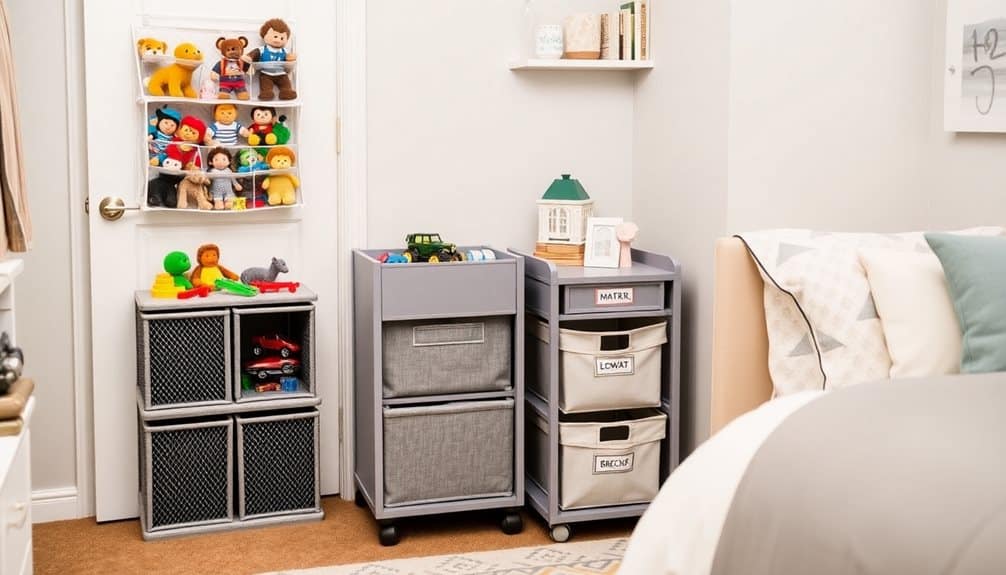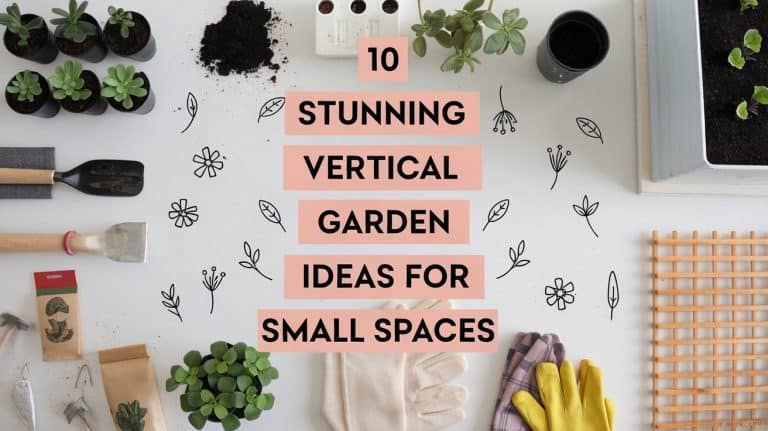This website contains affiliate links. Some products are gifted by the brand to test. As an Amazon Associate, I earn from qualifying purchases. The content on this website was created with the help of AI.
You’ll find numerous budget-friendly solutions to tame toy chaos in small spaces. Transform unused vertical areas with behind-the-door organizers, wall-mounted mesh bags, or floating shelves that maximize storage without consuming floor space. Utilize the area under furniture with clear bins for easy visibility, or repurpose everyday kitchen containers like cookie jars and cereal dispensers. Create a rotating toy library system to keep only 25% of toys accessible while storing the rest, reducing clutter and maintaining children’s interest. Corner storage towers and labeled drawer carts offer additional flexibility for organizing various play items. These practical strategies represent just the beginning of your toy storage transformation.
Key Takeaways
- Behind-the-door organizers with clear pockets maximize vertical space and store up to 30 pounds of toys without taking floor space.
- Under-bed clear storage bins protect toys from dust while utilizing otherwise wasted space beneath furniture.
- Repurposed kitchen containers like cookie jars and cereal containers offer free storage solutions for small toys and art supplies.
- Wall-mounted mesh bags provide affordable, breathable storage that can be customized to different heights and labeled for organization.
- Corner storage towers transform unused corner spaces into organized toy zones with adjustable shelves at child-accessible heights.
Behind-the-Door Storage Systems

Behind-the-door storage systems transform unused vertical space into valuable toy organization zones. You’ll find these systems particularly effective in children’s bedrooms, playrooms, or closets where floor space is limited. Most models feature clear plastic pockets or mesh compartments that let you quickly identify stored items while keeping them dust-free and easily accessible.
When selecting a door organizer, measure your door’s dimensions and choose a system that hangs at least 3 inches below the doorknob. Look for reinforced stitching at stress points and strong metal hooks that won’t damage the door. You’ll want adjustable straps to guarantee the organizer hangs straight and doesn’t swing when opening or closing the door.
Maximize the system’s efficiency by grouping similar toys together: dedicate upper pockets to lightweight items like stuffed animals and action figures, while using lower compartments for heavier toys and games. Label each pocket clearly to encourage your children to maintain organization. For added stability, consider installing adhesive strips at the bottom corners to prevent movement. You’ll find these systems typically hold 20-30 pounds of toys, depending on the model’s construction quality. Our storage bin solutions come in various styles to match your home’s decor while keeping toys organized.
Clear Bins Under Furniture
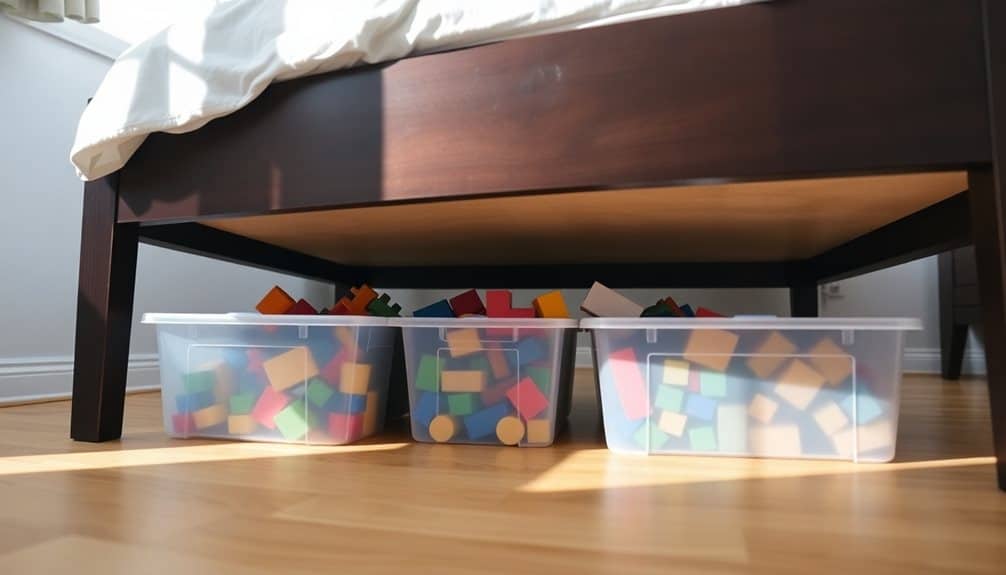
Three key advantages make clear storage bins under furniture an efficient toy storage solution: space optimization, easy visibility, and dust protection.
You’ll maximize your room’s square footage by utilizing the often-wasted space under beds, sofas, and dressers. Choose low-profile bins that slide smoothly on your flooring surface, and measure your clearance height carefully before purchasing. The transparent nature of these containers lets you quickly spot specific toys without pulling out multiple bins, saving valuable time during cleanup and playtime.
To implement this system effectively, select bins with secure lids to prevent dust accumulation and protect toys from moisture. Add wheels to heavier containers for easier access, and consider using bin dividers to separate smaller items. Label each container’s contents, even though they’re clear, to maintain organization when toys are temporarily removed.
For best results, opt for bins made from durable polypropylene or acrylic materials that won’t crack under pressure. Stick to standardized sizes that’ll fit multiple furniture pieces, and don’t forget to leave a few inches of clearance for easy sliding. This system works particularly well for seasonal toys, extra building blocks, and board games.
Look for containers with airtight snap-lock latches to ensure maximum protection against humidity and external contaminants while keeping toys fresh and clean.
Wall-Mounted Mesh Bags
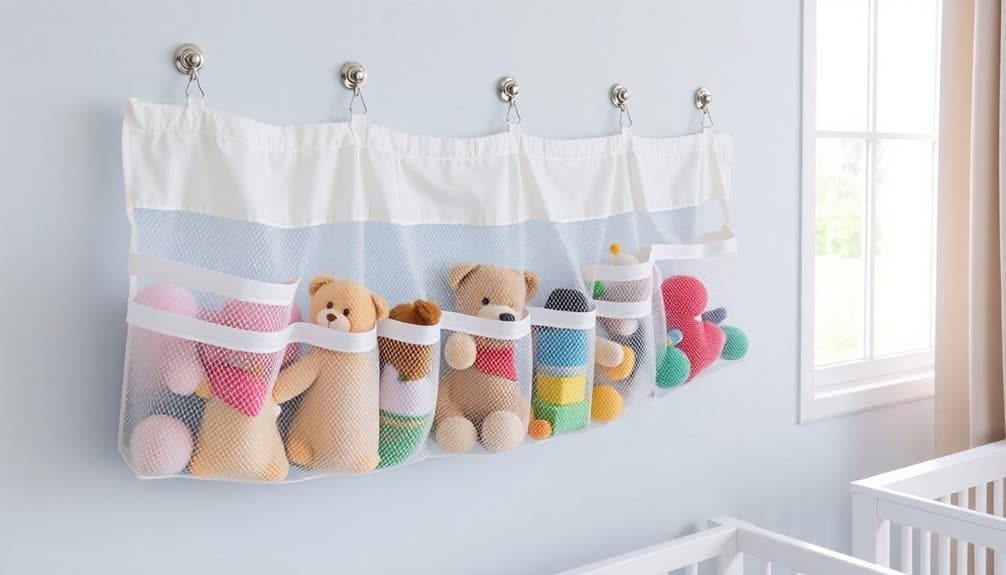
Looking for a lightweight storage solution that maximizes vertical space? Wall-mounted mesh bags offer an affordable and versatile option for storing your children’s toys while keeping them easily accessible. You’ll find these bags particularly useful for stuffed animals, sports equipment, and lightweight plastic toys.
Install multiple mesh bags at different heights to create a customized storage system that grows with your child. You can mount them using heavy-duty hooks or brackets, guaranteeing they’re securely anchored to wall studs. Choose bags with reinforced edges and durable mesh material to prevent tearing under regular use. Most mesh bags feature drawstring closures or wide openings, making it simple for kids to retrieve and return toys independently.
To optimize organization, you’ll want to color-code the bags or add labels for different toy categories. Position frequently used items in lower bags while storing seasonal or occasional-use toys in higher ones. The breathable mesh material prevents moisture buildup and allows you to spot contents quickly. When selecting mounting locations, make sure there’s adequate clearance for the bags to hang fully extended, typically allowing 12-18 inches of projection from the wall. For enhanced safety and stability, consider implementing anti-tipping devices similar to those used with traditional storage cubbies.
Rotating Toy Library Method

The toy rotation system offers a practical approach to managing your child’s playthings while maintaining their interest and reducing clutter. You’ll need to organize toys into four distinct categories based on type, age-appropriateness, and play value. Store three-quarters of these items in labeled, stackable bins out of sight, while keeping one-quarter accessible to your child.
Every two to three weeks, you’ll swap out the current toy selection with items from storage. As you rotate, observe which toys spark the most engagement and remove any damaged or outgrown items. Create a simple inventory list on your phone to track rotations and prevent toys from staying in storage too long.
To implement this system effectively, designate specific zones for different play activities: building blocks in one area, creative materials in another, and pretend play items in a third. You’ll find that limiting toy availability not only reduces daily cleanup time but also encourages deeper engagement with each item. Keep special toys, like favorite stuffed animals, in permanent circulation to maintain your child’s sense of security and routine. Consider using curved-bottom hopper storage bins to prevent small toys from getting stuck in corners and make retrieval easier for both parents and children.
Floating Shelves for Collections
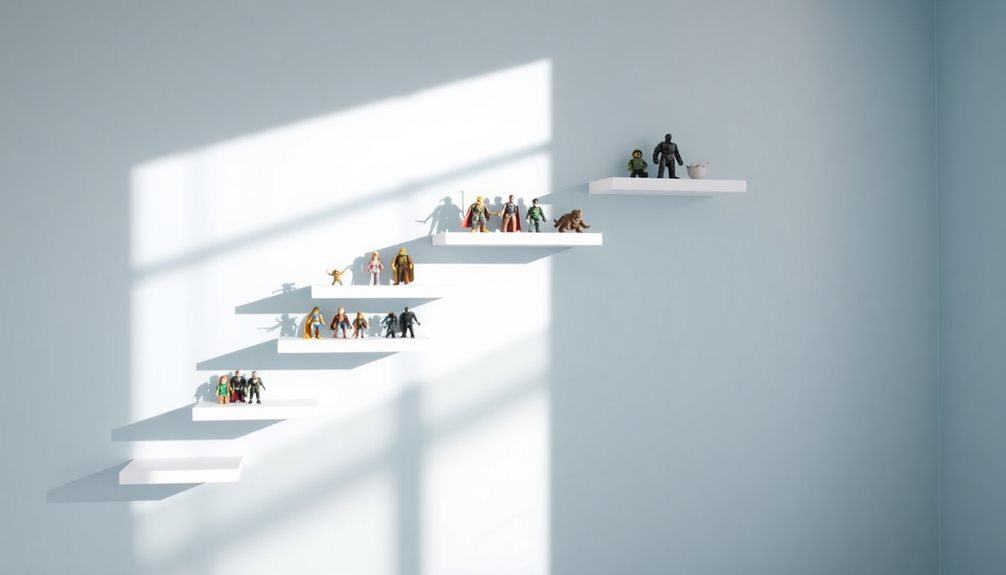
While the toy rotation system keeps most items tucked away, displaying cherished collections calls for a different storage approach. Floating shelves offer an elegant solution that maximizes vertical space without eating into your floor area. You’ll find these shelves particularly useful for showcasing action figures, model cars, or LEGO creations.
Install floating shelves at varying heights to create visual interest and accommodate different-sized toys. For safety, verify you’re anchoring them into wall studs or using appropriate wall anchors rated for the weight you’ll display. You’ll want to position shorter shelves at your child’s eye level, while keeping delicate or valuable pieces on higher shelves.
Choose shelves with lips or guardrails to prevent items from falling, and consider clear acrylic options that let you see the full display while protecting from dust. Don’t overcrowd the shelves – leave about 20% of space empty for visual breathing room and easy access. If you’re displaying LEGO sets, add small risers or stepped displays within the shelves to create depth and showcase each piece effectively. For optimal organization, consider adding picture labels to shelves to help children maintain proper toy categorization during cleanup time.
Over-Bed Storage Solutions
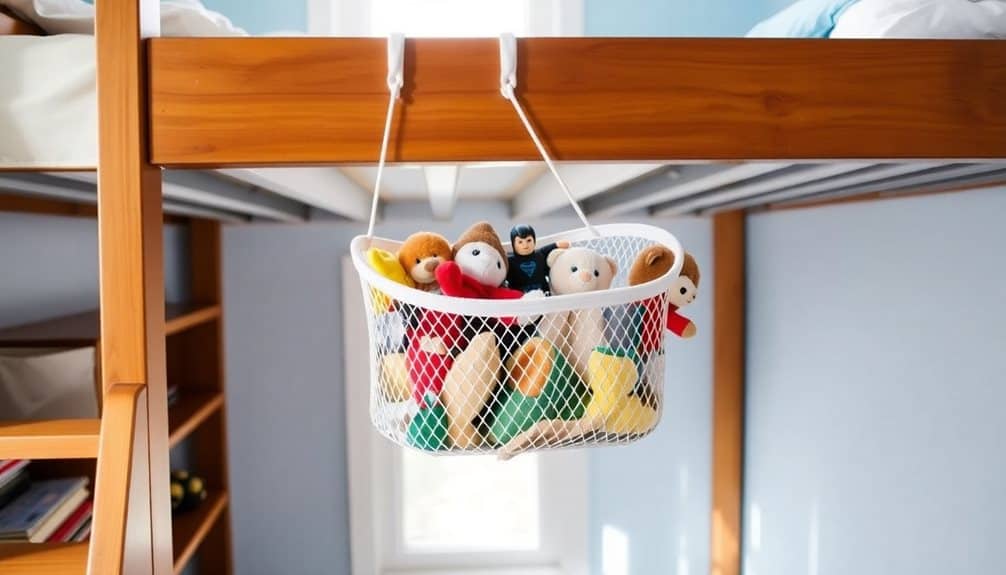
Making use of precious vertical space, over-bed storage solutions transform otherwise unused areas into valuable toy storage real estate. You’ll find several practical options to maximize this space, from suspended nets to wall-mounted cabinets that span the bed’s width. Installing a sturdy hanging organizer can create multiple compartments for stuffed animals, while mesh hammocks work perfectly for lightweight toys.
Consider installing floating cubbies or shelving units on either side of the bed, extending them across the headboard area. You’ll want to mount these at least 18 inches above the mattress for safety and accessibility. For a more all-encompassing solution, try a bed bridge shelf system that connects both sides of the bed with an overhead storage unit. These come with adjustable heights and often feature built-in lighting.
When selecting over-bed storage, you’ll need to factor in your ceiling height and guarantee all installations are properly anchored. Choose clear containers or open-front bins so your child can easily identify contents. Don’t forget to implement a logical organization system, keeping frequently used toys within arm’s reach and storing seasonal items in higher compartments.
Repurposed Kitchen Containers

Creative parents can transform everyday kitchen containers into practical toy storage solutions. You’ll find multiple opportunities to repurpose items like cookie jars, pasta containers, and large plastic food storage bins. Glass cookie jars work perfectly for storing small building blocks, marbles, or craft supplies, while offering clear visibility of the contents.
Consider using plastic cereal containers for arranging action figures, toy cars, or card games. Their pour spouts make it easy for children to retrieve items, and the sealed lids prevent spillage. Empty coffee canisters, once cleaned and decorated, become ideal holders for art supplies like markers, colored pencils, and paintbrushes.
You’ll maximize your storage potential by stacking multiple clear food storage containers, which work well for organizing puzzle pieces, board game parts, or small toy collections. Label each container clearly using adhesive labels or permanent markers. Mason jars in various sizes can store tiny toys like miniature dolls or game pieces, while large pickle jars accommodate bigger items such as stuffed animals or sports equipment. These kitchen-turned-toy containers fit easily on shelves, in closets, or under beds.
Corner Storage Towers
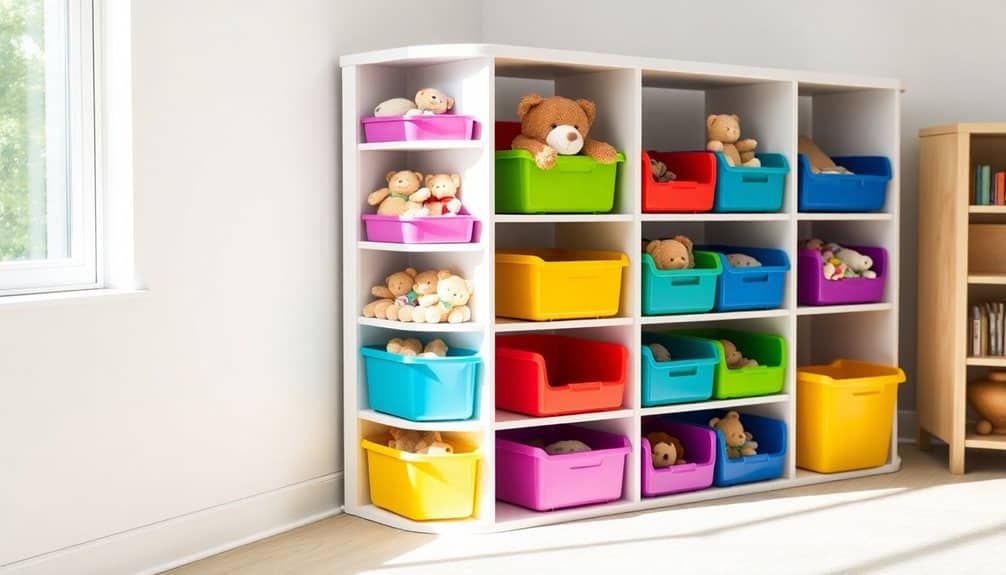
Corner storage towers maximize unused room angles by transforming dead space into vertical toy organization zones. You’ll find these towers in varying heights, typically ranging from 4 to 7 feet tall, with multiple shelves or cubbies that ascend in a triangular or quarter-circle shape. Most models feature adjustable shelves, allowing you to customize compartment sizes based on your toy collection.
When selecting a corner tower, measure your space carefully and leave at least 2 inches of clearance from adjacent walls. Look for units with a sturdy base and secure wall anchoring options to prevent tipping. You’ll want to choose between open shelving for easy access or doors to conceal clutter. Many towers come with built-in fabric bins that slide out smoothly, perfect for storing smaller toys like building blocks or action figures.
Install the lower shelves at your child’s height for independent access, and reserve upper levels for less-frequently used items or parent-supervised toys. Consider models with rounded edges and non-toxic finishes if you have young children. Clear labeling systems on each shelf or bin will help maintain organized zones for different toy categories.
Window Seat Organization

A window seat provides dual functionality as both a cozy reading nook and a smart storage solution for toys. You’ll maximize your space by installing built-in drawers beneath the seat or using rolling bins that slide underneath. These storage compartments can hold everything from building blocks and action figures to board games and stuffed animals.
To organize the space effectively, you’ll want to use clear plastic bins with labels, making it easy for kids to find and return their toys. Consider installing drawer dividers to create separate sections for different toy categories. For frequently used items, opt for bins with wheels that children can easily pull out and push back. You can also add cushioned storage ottomans that match your window seat’s upholstery for additional hidden storage.
Don’t forget to utilize the vertical space around your window seat. Install floating shelves on either side to display books and decorative storage boxes. If you’re dealing with smaller toys, use hanging organizers with multiple pockets on the adjacent walls. These practical additions will help maintain order while keeping toys within arm’s reach during playtime.
Labeled Drawer Cart Systems

Labeled drawer cart systems offer exceptional versatility for organizing toys throughout your home. You’ll find these portable units particularly useful for sorting smaller items like LEGOs, action figures, art supplies, and building blocks. Select a cart with clear drawers so your children can easily spot their toys, or opt for solid drawers with large, visible labels for a cleaner look.
When setting up your drawer cart system, you’ll want to categorize toys by type, size, or frequency of use. Create a simple labeling system using pictures for younger children who can’t read yet, or combine both text and images for early readers. You can use vinyl labels, adhesive label holders, or even colorful washi tape to mark each drawer clearly.
Position your cart where it’s most practical – beside a play table, under a desk, or in a closet. The wheels make it simple to move the unit when needed, while most carts include locks to keep them stationed. For maximum efficiency, assign the bottom drawers to heavier toys and reserve upper drawers for lighter, frequently accessed items.
Frequently Asked Questions
How Often Should I Rotate Toys to Maintain Children’s Interest?
You’ll want to rotate toys every 2-4 weeks to keep children engaged and prevent boredom. Divide toys into 4-6 groups, storing unused sets out of sight. Watch for your child’s cues – if they’re losing interest sooner, rotate more frequently. For infants and toddlers, consider weekly rotations, while preschoolers might do well with monthly switches. This practice helps maintain novelty and extends toys’ play value.
What’s the Recommended Height for Toy Storage That Kids Can Reach Safely?
Studies show that 85% of childhood accidents happen when kids try reaching items placed too high. For children aged 2-5, you’ll want to keep storage at 24-28 inches high, while 5-8 year-olds can safely reach 36-40 inches. Install shelves and storage units at your child’s shoulder height, and don’t encourage climbing. You’ll find they’re more likely to put toys away when storage is easily accessible.
How Do I Prevent Mold Growth in Toy Storage Containers?
You’ll prevent mold growth in toy storage containers by ensuring proper ventilation and maintaining low humidity. Don’t store damp or wet toys, and thoroughly dry items before placing them in containers. Use moisture-absorbing packets or silica gel sachets inside containers, especially in humid climates. Clean containers regularly with a vinegar solution, and drill small ventilation holes if using airtight bins. Keep storage areas away from bathrooms and basements.
Which Toy Storage Solutions Work Best for Shared Bedrooms?
Smart, stackable storage solutions work perfectly for shared spaces. You’ll want to invest in dual-sided organizers that let siblings access their toys from both sides. Under-bed rolling containers maximize floor space, while hanging organizers with labeled pockets help separate each child’s belongings. Install wall-mounted shelves at age-appropriate heights, and use color-coded bins to distinguish ownership. Don’t forget to add cushioned storage benches for extra seating and storage.
Are Vacuum Storage Bags Safe for Storing Stuffed Animals Long-Term?
You can safely store stuffed animals in vacuum bags for long periods if you follow proper precautions. First, clean and thoroughly dry the toys before storage. You’ll need to periodically release and re-vacuum the bags to prevent permanent compression damage. It’s best to include moisture absorbers inside the bags and store them in a cool, dry place. For delicate or antique plush toys, consider alternative storage methods.

